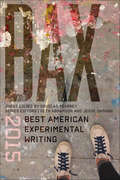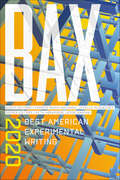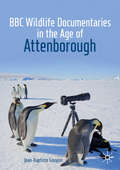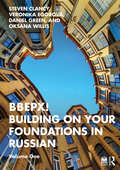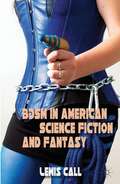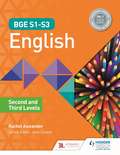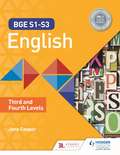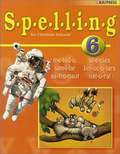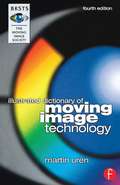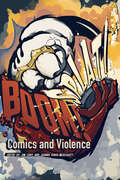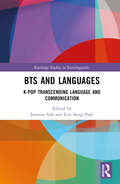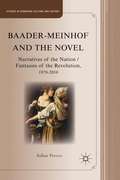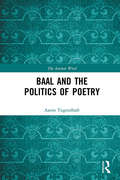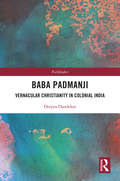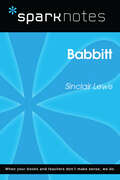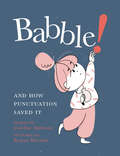- Table View
- List View
BAX 2015: Best American Experimental Writing (Best American Experimental Writing)
by Douglas Kearney, Seth Abramson and Jesse DamianiBAX 2015 is the second volume of an annual literary anthology compiling the best experimental writing in poetry, fiction, and creative nonfiction. This year's volume, guest edited by Douglas Kearney, features seventy-five works by some of the most exciting American poets and writers today, including established authors—like Dodie Bellamy, Anselm Berrigan, Thomas Sayers Ellis, Cathy Park Hong, Bhanu Kapil, Aaron Kunin, Joyelle McSweeney, and Fred Moten—as well as emerging voices. Best American Experimental Writing is also an important literary anthology for classroom settings, as individual selections are intended to provoke lively conversation and debate. The series coeditors are Seth Abramson and Jesse Damiani.Hardcover is un-jacketed.
BAX 2020: Best American Experimental Writing (Best American Experimental Writing)
by Seth Abramson, Jesse Damiani and Carmen Maria MachadoBAX 2020, guest-edited by Joyelle McSweeney and Carmen Maria Machado, is the sixth edition of the critically acclaimed anthology series compiling an exciting mix of fiction, poetry, non-fiction, and genre-defying work. Featuring a diverse roster of new and established authors—including Anne Boyer, Alice Notley, and Raquel Salas Rivera—BAX 2020 presents an expansive view of high-energy writing.from Okazaki Fragments by Kanika AgrawalThese proceedings in natureThese proceedings in cold biology These proceedings in chemical societyThese proceedings in physical communicationWe refer to the concentration of residues We observe that one sediments faster than the otherWe presume as fact that most of what we do is in growing incomplete short chainsWe further support the conclusion We indicate direction also by another methodWe are grateful to Drs.
BBC Wildlife Documentaries in the Age of Attenborough (Palgrave Studies in Science and Popular Culture)
by Jean-Baptiste GouyonThis book explores the history of wildlife television in post-war Britain. It revolves around the role of David Attenborough, whose career as a broadcaster and natural history filmmaker has shaped British wildlife television. The book discusses aspects of Attenborough’s professional biography and also explores elements of the institutional history of the BBC—from the early 1960s, when it was at its most powerful, to the 2000s, when its future is uncertain. It focuses primarily on the wildlife ‘making-of’ documentary genre, which is used to trace how television progressively became a participant in the production of knowledge about nature. With the inclusion of analysis of television programmes, first-hand accounts, BBC archival material and, most notably, interviews with David Attenborough, this volume follows the development of the professional culture of wildlife broadcasting as it has been portrayed in public. It will be of interest to wildlife television amateurs, historians of British television and students in science communication.
BBEPX! Building on Your Foundations in Russian: Volume One
by Daniel Green Steven Clancy Veronika Egorova Oksana WillisВверх! Building on Your Foundations in Russian is an innovative intermediate course that seamlessly blends rigorous grammar instruction with engaging and functional communicative class activities.The course revisits topics typically covered in introductory courses, allowing learners to consolidate and expand their foundational knowledge. A blend of cultural insights, reading, listening, and viewing exercises enrich students’ cultural understanding. By presenting a range of examples from a variety of contexts, topics, and genres, students gain a broad and deep understanding of the nuances of Russian. Designed for those progressing beyond the basics, Вверх! leverages a core vocabulary of 1,500 words and strategically expands it by an additional 2,500 essential words, employing a color-coded system for ease of learning. By the end of the course, students will understand up to 70-80% of words in commonusage.The Вверх! Building on Your Foundations in Russian course consists of two volumes, each with nine chapters, containing everything students and instructors need for a dynamic exploration of Russian at the intermediate level. A companion website with a downloadable workbook, glossary, vocabulary files, and audio and video resources brings the course to life. The blended and modular format makes it easy for instructors to adapt the material to their learning goals and timetabling constraints.
BDSM in American Science Fiction and Fantasy
by Lewis CallThis is a history of the decades-long love affair between a powerful alternative sexuality called BDSM (bondage/discipline, dominance/submission, sadism/masochism) and an innovative narrative genre called science fiction and fantasy (SF&F). The book shows how SF&F provides easy access to the language, symbols, rituals and ethics of BDSM. Science fiction and fantasy offer strikingly positive representations of BDSM, while the marginal status of SF&F ensures that these representations will not normalize BDSM out of existence. These sympathetic yet subversive representations encourage audiences to view BDSM as an ethical sexuality, while simultaneously permitting BDSM to retain its transgressive identity. This book explores representations of BDSM in the Wonder Woman comics of the 1940s, in the novels and short stories that Samuel Delany and James Tiptree wrote between the 1960s and 1980s, and in the television shows of the 1990s and 2000s: Buffy, Angel, Battlestar Galactica and Dollhouse.
BG's ABCs: Tackling Football and Life
by Brandon Graham Lesley Van ArsdallA is for attitude. B is for bravery. C is for confidence. That’s how Philadelphia Eagle Brandon Graham learned his ABCs. And now, with BG’s ABCs, you can too! In this charming alphabet book, Graham and Lesley Van Arsdall teach motivational words and leadership lessons to encourage dreams and educate young readers, helping the whole family set goals for hard work, imagination, and joy. BG’s ABCs emphasizes a never give up mindset while also teaching lessons of kindness and respect. Using BG’s ABCs as a guide, young readers are sure to achieve victory while also developing a zest for life!
BGE S1–S3 English: Second and Third Levels
by Rachel AlexanderSyllabus: CfE (Curriculum for Excellence, from Education Scotland) and SQALevel: BGE S1-3: Second & Third LevelSubject: EnglishBuild, strengthen and extend pupils' skills with this creative and collaborative approach to English. As they progress through a rich selection of text extracts, active learning tasks and end-of-chapter assessments, pupils will enjoy developing their Talk and Listening, Writing, Critical Reading and RUAE skills throughout S1-S3.Covering all CfE Second and Third Level Benchmarks for Literacy and English, this ready-made and fully differentiated BGE course puts progression for every pupil at the heart of your curriculum.- Boost confidence and competence in literacy and language: Active learning tasks are clearly marked as 'building', 'strengthening' and 'extending' so students can see how their skills are improving- Meet the needs of each pupil in your class: Carefully chosen text extracts and scaffolded activities support pupils working towards Level 2 and help you close the attainment gap- Effectively check and assess progress: Formative assessments at the end of each chapter help you monitor progression against the Experiences & Outcomes and Benchmarks (with additional assessments in the separate Planning & Assessment Pack)- Lay firm foundations for National qualifications: Covering all skills across Talk and Listening, Writing, Critical Reading, and Reading for Understanding, Analysis and Evaluation will set pupils up for success at National 5 and beyond
BGE S1–S3 English: Second and Third Levels
by Rachel AlexanderSyllabus: CfE (Curriculum for Excellence, from Education Scotland) and SQALevel: BGE S1-3: Second & Third LevelSubject: EnglishBuild, strengthen and extend pupils' skills with this creative and collaborative approach to English. As they progress through a rich selection of text extracts, active learning tasks and end-of-chapter assessments, pupils will enjoy developing their Talk and Listening, Writing, Critical Reading and RUAE skills throughout S1-S3.Covering all CfE Second and Third Level Benchmarks for Literacy and English, this ready-made and fully differentiated BGE course puts progression for every pupil at the heart of your curriculum.- Boost confidence and competence in literacy and language: Active learning tasks are clearly marked as 'building', 'strengthening' and 'extending' so students can see how their skills are improving- Meet the needs of each pupil in your class: Carefully chosen text extracts and scaffolded activities support pupils working towards Level 2 and help you close the attainment gap- Effectively check and assess progress: Formative assessments at the end of each chapter help you monitor progression against the Experiences & Outcomes and Benchmarks (with additional assessments in the separate Planning & Assessment Pack)- Lay firm foundations for National qualifications: Covering all skills across Talk and Listening, Writing, Critical Reading, and Reading for Understanding, Analysis and Evaluation will set pupils up for success at National 5 and beyond
BGE S1–S3 English: Third and Fourth Levels
by Jane CooperSyllabus: CfE (Curriculum for Excellence, from Education Scotland) and SQALevel: BGE S1-3: Third & Fourth LevelSubject: EnglishBuild, strengthen and extend pupils' skills with this creative and collaborative approach to English. As they progress through a rich selection of text extracts, active learning tasks and end-of-chapter assessments, pupils will enjoy developing their Talk and Listening, Writing, Critical Reading and RUAE skills throughout S1-S3.Covering all CfE Third and Fourth Level Benchmarks for Literacy and English, this ready-made and fully differentiated BGE course puts progression for every pupil at the heart of your curriculum.- Boost confidence and competence in literacy and language: Active learning tasks are clearly marked as 'building', 'strengthening' and 'extending' so students can see how their skills are improving- Meet the needs of each pupil in your class: The content and activities are designed to ensure accessibility for those with low prior attainment, while plenty of stretch and challenge is provided for higher ability pupils- Effectively check and assess progress: Formative assessments at the end of each chapter help you monitor progression against the Experiences & Outcomes and Benchmarks (with additional assessments in the separate Planning & Assessment Pack)- Lay firm foundations for National qualifications: Covering all skills across Talk and Listening, Writing, Critical Reading, and Reading for Understanding, Analysis and Evaluation will set pupils up for success at National 5 and beyond
BGE S1–S3 English: Third and Fourth Levels
by Jane CooperSyllabus: CfE (Curriculum for Excellence, from Education Scotland) and SQALevel: BGE S1-3: Third & Fourth LevelSubject: EnglishBuild, strengthen and extend pupils' skills with this creative and collaborative approach to English. As they progress through a rich selection of text extracts, active learning tasks and end-of-chapter assessments, pupils will enjoy developing their Talk and Listening, Writing, Critical Reading and RUAE skills throughout S1-S3.Covering all CfE Third and Fourth Level Benchmarks for Literacy and English, this ready-made and fully differentiated BGE course puts progression for every pupil at the heart of your curriculum.- Boost confidence and competence in literacy and language: Active learning tasks are clearly marked as 'building', 'strengthening' and 'extending' so students can see how their skills are improving- Meet the needs of each pupil in your class: The content and activities are designed to ensure accessibility for those with low prior attainment, while plenty of stretch and challenge is provided for higher ability pupils- Effectively check and assess progress: Formative assessments at the end of each chapter help you monitor progression against the Experiences & Outcomes and Benchmarks (with additional assessments in the separate Planning & Assessment Pack)- Lay firm foundations for National qualifications: Covering all skills across Talk and Listening, Writing, Critical Reading, and Reading for Understanding, Analysis and Evaluation will set pupils up for success at National 5 and beyond
BJU Spelling 6
by Bju PressBJU Spelling 6 presents a variety of spelling exercises, etymology sections, and studies of common Greek and Latin word roots. Spelling lists are arranged by groups of similar words to help students defeat common spelling errors.
BK English: Communication Skills in the New Millennium (Grade #6)
by J. A. Senn Carol Ann SkinnerEnglish textbook for 6th graders.
BK English: Communication Skills in the New Millennium (Grade #7)
by J. A. Senn Carol Ann SkinnerGood writing is easy to read. It may be so smooth and flowing that it seems as though the writer simply sat down and wrote it all out in complete form. Chances are, however, that the writing took time and effort. Good writing only appears effortless.
BK English: Communication Skills in the New Millennium (Grade 9, Level #1)
by J. A. Senn Carol Ann SkinnerCommunication textbook for 9th graders.
BK English: Communication Skills in the New Millennium (Level III)
by J. A. Senn Carol Ann SkinnerA study guide for students to learn English.
BKSTS Illustrated Dictionary of Moving Image Technology
by Martin UrenThe fourth edition of the BKSTS dictionary provides clear and concise explanations of the terminology and acronyms encountered in the broadcasting and moving image industries. Convergence of these industries means that those practising within them are increasingly faced with unfamiliar terminology. Martin Uren has reflected this change in his extended choice of industry terms, acronyms and colloquialisms. He provides:- Over 3300 definitions covering film, television, sound and multimedia technologies, together with technical terms from the computing, networks and telecommunications industries.- Nearly 700 acronyms in a quick look-up section.- 26 Appendices of useful technical information across a range of topics. Whether you are an experienced professional or a new industry entrant, you will find this dictionary an essential reference for every-day and specialist jargon.Martin Uren is a broadcast training consultant and member of the Education and Training Committee and the Television Committee of the BKSTS. He is also a member of the SMPTE and the RTS.BKSTS, The Moving Image Society, represents the interests of those who are creatively and technologically involved in the business of providing moving images in all areas of the media.
BOOM! SPLAT!: Comics and Violence
by Jim Coby and Joanna Davis-McElligattContributions by Lawrence Abrams, Diana Álvarez Amell, Partha Bhattacharjee, Natalja Chestopalova, Jim Coby, Rita Costello, Sam Cowling, Joanna Davis-McElligatt, Elisabetta Di Minico, Kiera M. Gaswint, Vincent Haddad, Kaleb Knoblauch, Christina M. Knopf, Leah Milne, Jacob Murel, Priyanka Tripathi, and Steven S. Vrooman In 1954, the culture, distribution, and content of comics forever changed. Long a mainstay of America’s reading diet, comic books began to fall under the scrutiny of parent groups, church leaders, and politicians. The bright colors and cheaply printed pulp pages of comic books that had once provided an escape were suddenly presumed to house something lascivious, insidious, and morally corrosive. While anxieties about representations of violence in comics have largely fallen to the wayside since the moral panic of the 1950s, thematic and symbolic visual depictions of violence remain central to the comics form. BOOM! SPLAT! Comics and Violence examines violence in every iteration—physical violence enacted between people and their environments, formal and structural violence embedded in the comics language itself, representations of historical violence, and ways of reading and seeing violence.BOOM! SPLAT! is composed of fifteen essays from renowned comics scholars and is organized thematically into four sections, including an examination of histories of violence, forms of violence, modes and systems of violence, and political and social violence. Chapters focus on well-known comics and comics creators, such as Steve Ditko, Hulk, X-Men, and the Marvel universe, to newspaper cartoon strips, postwar graphic novels, revolution, civil rights, trauma, #blacklivesmatter, and more. BOOM! SPLAT! serves as a resource to scholars and comics enthusiasts who wish to contemplate and confront the permutations, forms, structures, and discourses of violence that have always animated cartoons. Through this interrogation, our understanding of violence moves beyond the immediately physical and interpersonal into modes of ephemeral, psychological, and ideological violence. Contributors fill critical gaps by offering sustained explorations of the function of manifold violences in the comics language—those seen, felt, and imagined. The essays in this collection are critically necessary for understanding the current and historical role that violence has played in comics and will help recognize how cartooning imbricates, resists, and expands our thinking about and experiences of violence.
BTS and Languages: K-pop Transcending Language and Communication (Routledge Studies in Sociolinguistics)
by Eun Sung Park Joowon SuhWith the international rise of K-pop culture, this analysis of BTS and the languages surrounding and related to their music, fans, and media content provides a unique look into how languages are localized, hybridized, and utilized beyond popular entertainment.Drawing on a wide range of data, the book examines various BTS-related content, from their music to the content generated by both BTS themselves and their fans. Chapters explore key sociolinguistic issues using BTS’s language as data, including their songs, lyrics, tweets, and interviews, and languages of BTS consumers, including fan interactions, reaction videos, commercials, as well as BTS-inspired signs and sounds in public places. With their phenomenal success in the global music market and ever-dominant presence on social media, BTS has inspired scholarly interest in academic fields such as culture and media studies, musicology, sociology, and business marketing, shedding light on effective communication and innovative language use.As the very first scholarly collection on BTS-related language, this book will be of interest to students and scholars studying language use and communication, including linguistic hybridity, multimodality, translanguaging practices, and multilingual communication.
Baader-Meinhof and the Novel
by Julian PreeceThe Baader-Meinhof Group and other violent underground organizations have provided material to many novels by leading German and international writers. This book is the first to examine this rich literary corpus, treating it as a political unconscious which expresses submerged anxieties and moral blind-spots in Europe's most powerful country.
Baal and the Politics of Poetry (The Ancient Word)
by Aaron TugendhaftBaal and the Politics of Poetry provides a thoroughly new interpretation of the Ugaritic Baal Cycle that simultaneously inaugurates an innovative approach to studying ancient Near Eastern literature within the political context of its production. The book argues that the poem, written in the last decades of the Bronze Age, takes aim at the reigning political-theological norms of its day and uses the depiction of a divine world to educate its audience about the nature of human politics. By attuning ourselves to the specific historical context of this one poem, we can develop more nuanced appreciation of how poetry, politics, and religion have interacted—in antiquity, and beyond.
Baba Padmanji: Vernacular Christianity in Colonial India (Pathfinders)
by Deepra DandekarThis book is a critical biography of Baba Padmanji (1831-1906), a firebrand native Christian missionary, ideologue, and litterateur from 19th-century Bombay Presidency. Though Padmanji was well-known, and a very influential figure among Christian converts, his contributions have received inadequate attention from the perspective of ‘social reform’ — an intellectual domain dominated by offshoots of the Brahmo Samaj movement, like the Prarthana Samaj in Bombay. This book constitutes an in-depth analysis of Padmanji’s relationships with questions of reform, education, modernity, feminism, and religion, that had wide-ranging repercussions on the intellectual horizon of 19th-century India. It presents Padmanji’s integrated writing persona and identity as a revolutionary pathfinder of his times who amalgamated and blended vernacular ideas of Christianity together with early feminism, modernity, and incipient nationalism. Drawing on a variety of primary and secondary sources, this unique book will be of great interest for area studies scholars (especially Maharashtra), and to researchers of modern India, engaged with the history of colonialism and missions, religion, global Christianity, South Asian intellectual history, and literature.
Babar's ABC (Babar #27)
by Laurent De BrunhoffThe publisher describes this book well: Join Babar, Celeste, Arthur, Zephir, and all the other characters of Celesteville as they take young readers on a lively romp through the alphabet. In this delightful and charming book, crocodiles chase crows, geese go through the garden gate, kittens love kisses, and pigs wear-what else?-purple pajamas!
Babbitt (SparkNotes Literature Guide Series)
by SparkNotesBabbitt (SparkNotes Literature Guide) by Sinclair Lewis Making the reading experience fun! Created by Harvard students for students everywhere, SparkNotes is a new breed of study guide: smarter, better, faster.Geared to what today's students need to know, SparkNotes provides:chapter-by-chapter analysis explanations of key themes, motifs, and symbols a review quiz and essay topicsLively and accessible, these guides are perfect for late-night studying and writing papers.
Babble!: And How Punctuation Saved It
by Caroline AddersonA village is torn apart by its residents' inability to communicate, until a little girl shares the gift of punctuation in this humorous illustrated parable.Chaos reigns in the village of Babble! All day, the residents fight, yell and argue, and no one is heard or understood . . . until a mysterious little girl arrives and gives the locals something very strange: a period. But what is this thing that looks like a freckle or a spot? The villagers don't even know how to ask. However, as the girl begins to share more gifts — a question mark, quotation marks — the residents slowly learn how to communicate. But when more fights arise and disaster strikes, can punctuation truly save the day?
Babe, the Big Hit
by Barbara W. Makar"Decodable Storybooks 2A accompany More Workbook 2 and provide additional opportunity to apply the phonetic concepts introduced in Workbook 2 to connected text. The storybooks use the same vocabulary as Workbook 2 and Storybooks 2 with the addition of one sight word was. Storybooks 2A are an excellent tool to reinforce the skills from Workbook 2 and can be used with either Workbook 2 or More Workbook 2"--Epsbooks.com.
